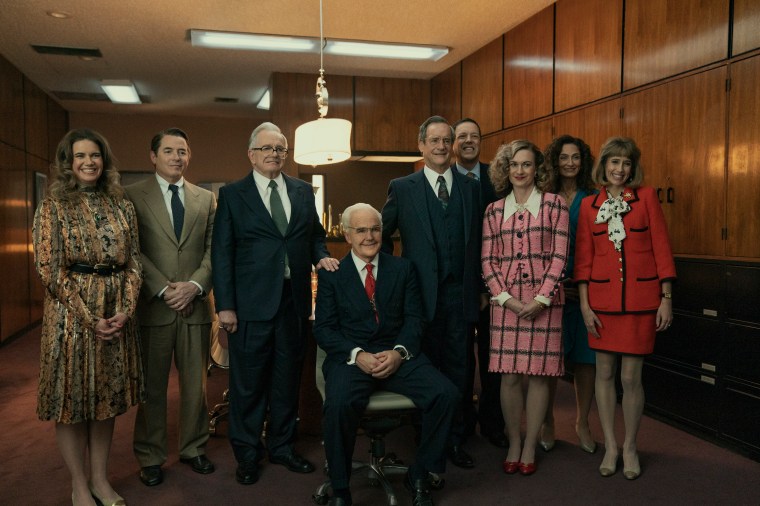Netflix is continuing the debate around the opioid crisis in America with its new drama Painkiller.
It is a fictionalised account of Purdue Pharma’s development of OxyContin, an addictive opioid drug that was sold in huge amounts.
Is Painkiller a true story?
Yes and no. It is based on real events, but like many dramatisations, there are elements of fiction as well.
The Netflix synopsis reads: “A fictionalised retelling of events, Painkiller is a scripted limited series that explores some of the origins and aftermath of the opioid crisis in America, highlighting the stories of the perpetrators, victims, and truth-seekers whose lives are forever altered by the invention of OxyContin.
“An examination of crime, accountability, and the systems that have repeatedly failed hundreds of thousands of Americans, Painkiller is based on the book Pain Killer by Barry Meier and the New Yorker Magazine article ‘The Family That Built an Empire of Pain’ by Patrick Radden Keefe.”
It stars Uzo Aduba, Matthew Broderick, Taylor Kitsch, Dina Shihabi, and West Duchovny.
Purdue Pharma launched OxyContin onto the market in 1996. The sales of the drug increased “from $44 million (316,000 prescriptions dispensed) in 1996 to a 2001 and 2002 combined sales of nearly $3 billion (over 14 million prescriptions)”, according to Netflix.
Around $200 million was spent on the marketing and promotion of the drug in 2001 alone.
The opioid crisis in America has been tied to the launch of OxyContin, with some experts saying it was marketed too widely considering its addictive qualities.
What happened to Purdue Pharma?
Netflix writes on its Tudum website: “In the face of 2,600 federal and state lawsuits filed against the company for its role in the opioid epidemic, Purdue Pharma filed for bankruptcy in 2019. In September 2021, Painkiller was already in production when the news broke that Purdue Pharma was being dissolved and a federal judge had ordered the Sacklers to pay $4.5 billion in exchange for the family receiving legal protections.
“The case has gone back and forth in appeals, with a judge overturning the settlement in December 2021 because the former ruling released the Sacklers of liability in civil opioid-related cases. In May 2023, the Sacklers agreed to pay a potential $6 billion settlement in return for that “golden key” of protections for the family. It is believed the Sacklers are worth over $11 billion. As of Aug. 10, 2023 — the day of Painkiller’s release on Netflix — the Supreme Court agreed to consider the Justice Department’s challenge to the deal, putting the settlement on pause. The justices will hear arguments in the case in December, per the court’s order.”
Purdue Pharma will be dissolved, along with UK arm, Mundipharma. The funds will go towards the $6 billion settlement of which $750 million goes to victims and families of those affected. $3 billion of the settlement is coming from the family’s own fortune.
Where is Richard Sackler now?
Richard Sackler, played by Matthew Broderick on the show, joined Purdue, where his father was president, after medical school and was part of the research that ultimately produced the extended-release form of OxyContin.
Sackler became president of Purdue Pharma in 1991 and became co-chairman in 2003. At this time $1.6 billion in OxyContin had already been sold.
He had been involved in pioneering the marketing schemes that sold OxyContin and in 2015, he was deposed before his company paid out a $24 million settlement. Purdue appealed this in 2017 and the case is ongoing.
It has been reported that in 2008, Sackler made Purdue measure its ‘performance’ in proportion to not only how many it sold but also the strength of the doses, despite allegedly knowing that these could have serious side effects, including addiction.

In 2019, an email disclosed in a Massachusetts court case showed Sackler allegedly attempting to shift blame for the crisis onto the individual users themselves, rather than his company.
It stated: “We have to hammer on the abusers in every way possible. They are the culprits and the problem. They are the reckless criminals.”
Sackler is still alive, lives in Florida, and turned 78 in March this year.
As Painkiller states: “No member of the Sackler family has ever been criminally charged in connection with the marketing of OxyContin, or any overdose deaths involving the drug.”
The Sacklers have admitted to no wrongdoing themselves, despite the claims brought against Purdue.
The Sacklers said in a statement earlier this year: “The Sackler families believe the long-awaited implementation of this resolution is critical to providing substantial resources for people and communities in need.”
Sackler put his Beverley Hills home up for sale in February of this year. It was listed for just under $20 million and is a three-story four-bed, six-bath home.
He also sold one on Cicero Lane in Austin, Texas, in 2018 for more than $3 million and one in Boca Raton, Florida, for $4.88 million in 2022.
He currently lives in a second house in Boca Raton, which cost $1.71 million in June 2021.
Institutions like the Serpentine Gallery, the V&A Museum, the British Museum and the National Gallery have removed the Sackler family name from their rooms.
